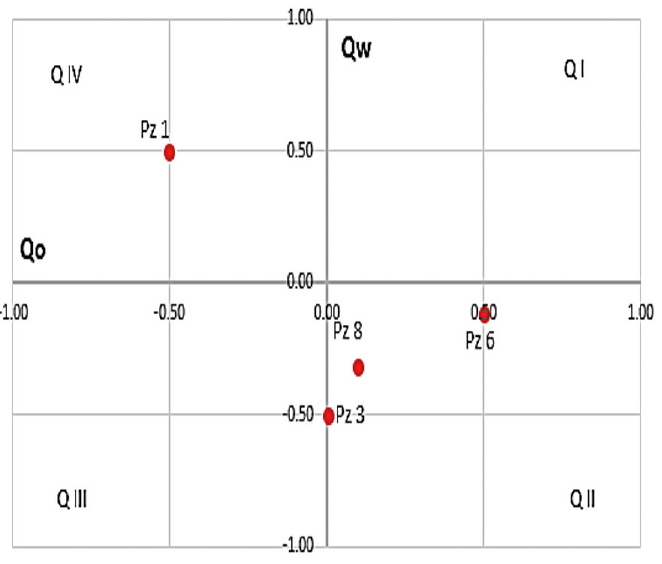
Published 2020-03-11
Keywords
- Production,
- Water formation,
- Re-injection well,
- Reservoir,
- Porosity and Permeability
How to Cite
Abstract
The demand for crude oil has not stopped growing, this means a gradual increase of wells drilled to maintain production, but the oil comes with a fossil water that means additional costs that make the competitiveness of the barrel of crude oil produced more expensive, we are talking about the formation water , today the production area takes this problem very seriously because its increase is proportional to the number of wells drilled and has an increase that is intrinsic to the rate of production due to the maturity of each well. This is a real challenge when managing these waters, which due to their composition can be addressed on two fronts, the first as a support mechanism in recovering crude oil, the second and more usual in Ecuador using a reinjection well to return these waters to the reservoir, the operation consists of choosing a receiving formation with good
petrophysical parameters that allow the admission of these fluids and keep them isolated, in this way any type of contamination to the groundwater and the environment will be avoided.
Downloads
References
Ayala, D., & Andrade, M. (2017). Factibilidad analítica de la aplicación de la recuperación mejorada de petróleo, caso de estudio Ecuador. Revista Fuentes, 15(2), 19-30.
Bolaños, I. (2002). Estudio de Ingeniería de Yacimientos.Quito: Petroproducción.
Díaz, C. (2007). Alcance de los Registros Acústicos de ültima Tecnología en Aplicaciones: Petrofísicas, Geológicas y Geomecánicas de los Pozos Perforados en el período 2002 - 2004 en la Cuenca Oriente Ecuatoriana.Quito: Escuela Politécnica Nacional.
Cruz, H. D. O., Duque, J. P. V., & Marulanda, J. F. F. (2015). Propuesta metodológica para el control y monitoreo de un proceso de inyección de agua. Revista Fuentes, 13(2).
Earle, H. (1996). The regulation of Deep-Weel Inyection: A Changing Enviromental Beneath the Surface.(P. E. Review, Ed.) Washington.
Irua, A. (2017). Metodología para la Identificación y Selección de Pozos con Oportunidades de Convertirse en Reinyectores en Campos Petroleros. Quito: Universidad Central del Ecuador.
Johnson, J., Werder, E., & Sebastian, D. (2016). Wasteater Disponsal Wells, Fracking, and Enviromental Injustice in Souther Texas. Houston: American Plublic Health Association.
Khatib, Z., & Verbeek, P. (2002). Water to Value - Produced Water Management for Sustainable Field Development of Mature and Green Fields, SPE 73853.
Kuala Lumpur: SPE.López, T., Peralta, F., & Dumani, M. (2013). Estudio Técnico de Pozos no Productivos para seleccionar reinyectores, diseño y costos de facilidades de Superficieen el Campo Paco, provincia de Santa Elena. La Libertad: Universidad Estatal Península de Santa Elena.
Martin, C. A. G., & Páez, E. M. (2017). Efeito da salinidade na tensão interfacial do sistema óleo/agua em condições isobáricas e incremento gradual da temperatura. Revista Fuentes, 15(2), 117-124.
Meng, M., Mo, C., & Sanders, K. (2016). Evaluation the Feasibility of Using Producing Water from Oil and Natural Gas Production to Address Water Scarcity in California ́s Central Valley.Los Angeles: MDPI.
Peralta, F., & Dumani, M. (2013). Estudio Técnico de Pozos no Productivos para Seleccionar Potenciales Reinyectores, Diseño y Costo de Facilidades de Superficie en el Campo Pacoa, Provincia de Santa Elena. La Libertad: Universidad Estatal Península de Santa Elena.
Reese, R. (1996). Heterogeneity Index, SPE -36604-MS.Denver: SPE Annual Technical Conference and Exhibition.
Ramírez, A. T. O., Maldonado, D. F. M., & Rodríguez, E. D. O. (2019). Revisión general de la producción elevada de agua en la industria del petróleo. Fuentes, el reventón energético, 17(2), 39-50.
Ramos, L., & Marin, A. (2018). Evaluación y experiencias en el control de conificación en pozos con alto corte de agua en yacimientos con empuje hidráulico. Revista Fuentes, 16(2).
Sandoval, J. (2013). Metodología para la Identificación de Pozos con Oportunidades de Incremento de Producción en Campos Maduros.Quito: Universidad Central del Ecuador.
Sharma, M. (2012). Injection Water Manegement Opprtunities and Challenges. Austin: University of Texas at Austin.
Sun, G., Crouse, B., Freed, D. M., Xu, R., Bautista, J., Zhang, R., ... & Dressler, M. (2018). Polymer flooding–Does Microscopic Displacement Efficiency Matter?. Revista Fuentes, 16(2).
Toro, G. M., Herrera, J. J., Orrego, J. A., Rojas, F. A., Rueda, M. F., & Manrique, E. J. (2018). Effect of ionic composition in water: oil interactions in adjusted brine chemistry waterflooding: preliminary results. Fuentes: El reventón energético, 16(2), 73-82.
Veil, J., Puder, M., Elcock, D., & Redweik, R. (2004). A White Paper Describing Produced Water from Production of Crude Oil Natural Gas, and Coal Bed Methane.Chicago: Argone.
Velandia, J. L. P. (2013). Simulación numérica del flujo bifásico agua-petróleo en un medio poroso Fuentes: El reventón energético, 11(2), 10.